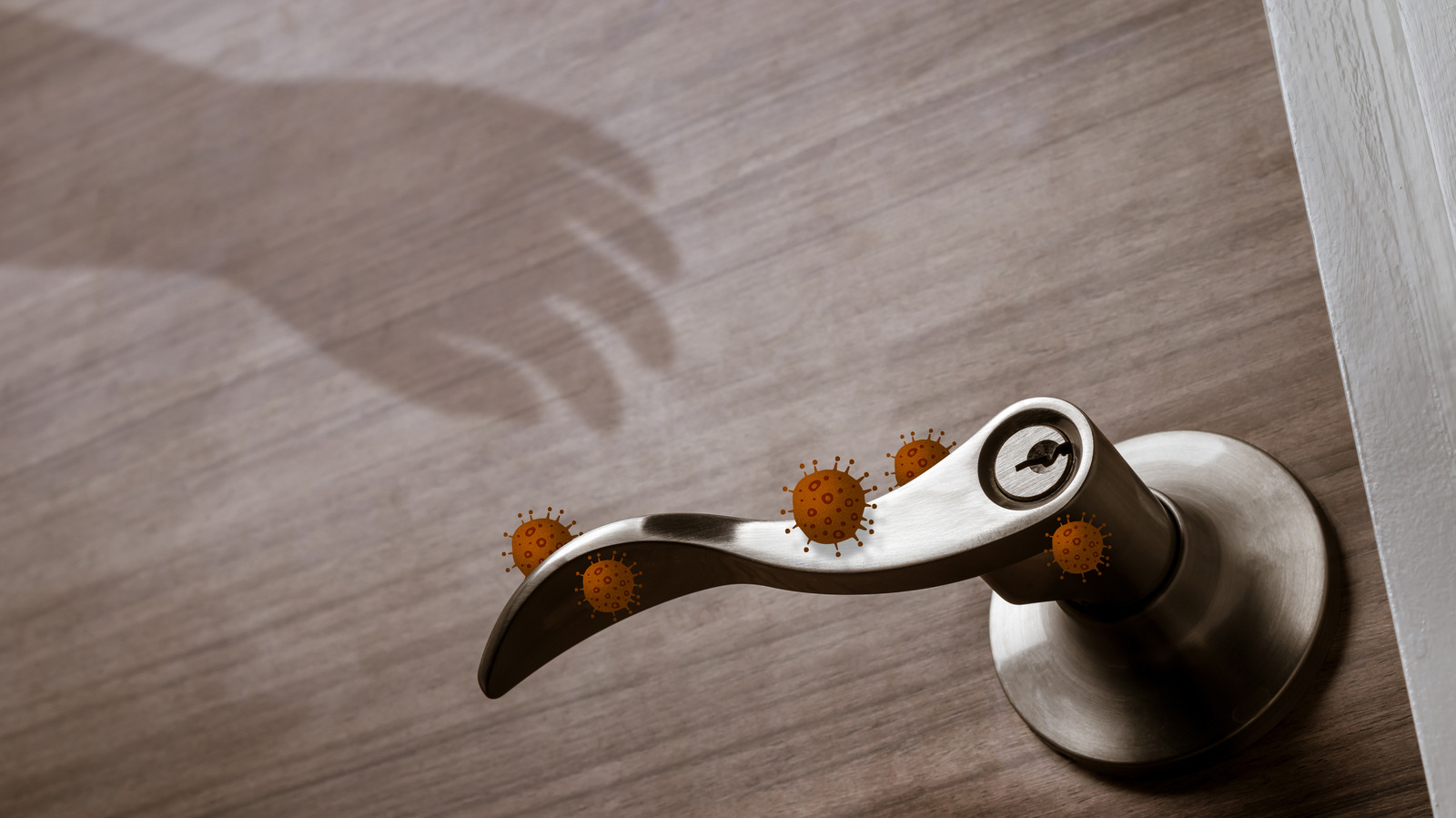Prevalence and Types of Bacteria on Bathroom Door Handles

Bathroom door handles, like many frequently touched surfaces, can harbor a variety of bacteria. These surfaces are often exposed to numerous individuals, making them potential breeding grounds for microorganisms. Understanding the prevalence and types of bacteria present on these handles is crucial for promoting hygiene and preventing the spread of infections.
Factors Contributing to Bacterial Prevalence
Several factors contribute to the high prevalence of bacteria on bathroom door handles. These include:
- High Frequency of Use: Bathroom door handles are touched frequently by individuals who may have been in contact with various surfaces, including toilets, sinks, and showers, potentially carrying bacteria on their hands.
- Environmental Conditions: Bathrooms are often warm and humid, providing ideal conditions for bacterial growth. The presence of moisture, particularly in areas like sinks and showers, can further contribute to bacterial proliferation.
- Hygiene Practices: Individuals may not always wash their hands thoroughly after using the bathroom, leading to the transfer of bacteria to the door handle. This is particularly important for individuals who are ill, as they may shed more bacteria.
Common Types of Bacteria Found on Bathroom Door Handles
While numerous bacteria can be found on bathroom door handles, some of the most common include:
- Staphylococcus aureus (S. aureus): This bacterium is commonly found on skin and can cause skin infections, food poisoning, and pneumonia.
- Escherichia coli (E. coli): Primarily found in the intestines, E. coli can cause urinary tract infections, diarrhea, and other gastrointestinal problems.
- Pseudomonas aeruginosa: This bacterium is often found in water and can cause skin infections, pneumonia, and other infections, particularly in individuals with weakened immune systems.
- Streptococcus pyogenes: This bacterium can cause strep throat, skin infections, and other illnesses.
Research Findings on Bacterial Counts
Studies have shown that bathroom door handles can harbor a significant number of bacteria. For instance, a study published in the journal “Applied and Environmental Microbiology” found that an average of 1,200 bacterial colonies were present per square inch on bathroom door handles. This number can vary depending on factors such as the frequency of use, cleaning practices, and environmental conditions.
Transmission and Health Risks

Bathroom door handles are frequently touched surfaces, serving as potential vectors for the transmission of various bacteria. These bacteria can be transferred from one person to another through direct contact, leading to potential health risks.
Routes of Transmission
The transmission of bacteria from bathroom door handles to individuals occurs through direct contact. When an infected individual touches a door handle, they leave behind bacteria on the surface. Subsequently, another person touching the same door handle can pick up these bacteria and transfer them to their hands. From there, the bacteria can enter the body through various means, such as:
- Touching the eyes, nose, or mouth: This is a common route of entry for bacteria, as these areas are often touched without conscious thought.
- Consuming food or drinks: If hands are not washed thoroughly after touching a contaminated door handle, bacteria can be transferred to food or drinks, leading to ingestion and potential illness.
- Open wounds or cuts: Bacteria can easily enter the body through open wounds or cuts, increasing the risk of infection.
Health Risks Associated with Bacteria on Door Handles, Bacteria on bathroom door handles
Exposure to bacteria on bathroom door handles can pose a range of health risks, including:
- Gastrointestinal infections: Bacteria such as *Salmonella* and *E. coli* can cause diarrhea, vomiting, and abdominal cramps. These infections are commonly spread through contaminated food or surfaces, including door handles.
- Skin infections: Bacteria like *Staphylococcus aureus* can cause skin infections such as boils, impetigo, and cellulitis. These infections are often spread through direct contact with contaminated surfaces, including door handles.
- Respiratory infections: Bacteria such as *Streptococcus pneumoniae* can cause respiratory infections like pneumonia and bronchitis. These infections can be spread through contact with contaminated surfaces, including door handles, followed by touching the nose or mouth.
- Eye infections: Bacteria such as *Haemophilus influenzae* can cause conjunctivitis, also known as “pink eye.” This infection is often spread through direct contact with contaminated surfaces, including door handles, followed by touching the eyes.
Examples of Diseases Transmitted through Contaminated Door Handles
Several diseases can be transmitted through contact with contaminated bathroom door handles. Some common examples include:
- Norovirus: This highly contagious virus causes vomiting and diarrhea, and can easily spread through contaminated surfaces, including door handles. It is a common cause of outbreaks in schools, hospitals, and other public places.
- Influenza: The influenza virus, commonly known as the flu, can also be transmitted through contaminated surfaces, including door handles. The virus can survive on surfaces for a few hours, making it easy to spread.
- Common cold: The common cold is caused by a variety of viruses, including rhinoviruses and coronaviruses. These viruses can survive on surfaces for several hours, making it possible to spread through contaminated door handles.
Hygiene Practices and Prevention

The presence of bacteria on bathroom door handles is a reality, and practicing proper hygiene is essential to prevent their transmission and protect ourselves from potential health risks. Implementing effective hygiene practices and adopting preventive measures can significantly minimize the risk of bacterial contamination.
Handwashing Techniques
Handwashing is a fundamental hygiene practice that effectively removes bacteria from our hands, preventing their spread to other surfaces and ultimately to ourselves. Here is a step-by-step guide on proper handwashing techniques:
- Wet your hands with clean, running water and apply soap.
- Rub your hands together vigorously for at least 20 seconds, ensuring all surfaces are covered, including the backs of your hands, between your fingers, and under your nails.
- Rinse your hands thoroughly under running water.
- Dry your hands with a clean towel or air dryer.
Minimizing Bacteria on Bathroom Door Handles
Regular cleaning and disinfection protocols are crucial for minimizing the presence of bacteria on bathroom door handles. Here are some practical tips:
- Regular Cleaning: Clean bathroom door handles regularly with soap and water, followed by disinfection with a bleach solution or other disinfectant wipes.
- Disinfection Frequency: Disinfect bathroom door handles at least once a day, especially after high-traffic periods or when someone in the household is sick.
- Touch-Free Alternatives: Consider using touch-free alternatives like automatic door openers or paper towel dispensers to minimize direct contact with door handles.
- Paper Towels: Encourage the use of paper towels to open and close doors, minimizing direct hand contact with the handles.
- Cleanliness Awareness: Promote awareness among household members about the importance of handwashing and maintaining clean surfaces to prevent the spread of bacteria.
Visual Representation
Bacteria on bathroom door handles –
[Insert infographic image here.]
The infographic visually depicts the most effective ways to prevent the transmission of bacteria from door handles. It highlights the importance of handwashing, using paper towels to open doors, and regularly disinfecting surfaces.
Right, so like, everyone knows bathroom door handles are a breeding ground for bacteria, right? But what if you could avoid touching them altogether? Well, you could totally upgrade your bathroom with a 24 inch barn door bathroom vanity ! It’s like, a totally sick way to save space and ditch those germ-infested handles.
Plus, it’ll make your bathroom look way more stylish. So, next time you’re thinking about bathroom upgrades, ditch the door handle and go for the barn door look!
Right, so you know how bathroom door handles are like, a breeding ground for germs, right? Well, if you’re worried about that, you could always get a frosted glass bathroom door , then you can just use your elbow to open it.
But even then, you still gotta wash your hands after, innit?